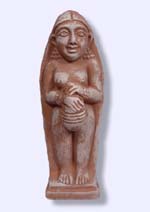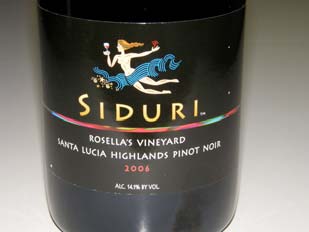Siduri Wines
Siduri is the Babylonian Goddess of wine and beer, merry making and wisdom. She is referred
to in The Epic of Gilgamesh as “the girl whose drinks refresh the soul.” It seemed only
appropriate that Pinot Noir enthusiasts, Adam and Dianna Lee, would stumble across the
goddess in a wine book written by Hugh Johnson, and adopt her for their winery's name. The
Lee’s have remarked, “We thought it was about time that someone other than Bacchus got
some credit for wine.” The label says, “Beside the sea she lives, the woman of the vine, the
maker of the wine.”
Siduri has the distinction of crafting more distinct Pinot Noir bottlings than any other producer in
California and Oregon. Since beginning modestly in 1994, the Lees have found an increasing and changing
number of outstanding vineyard sources for Pinot Noir stretching all the way from Oregon’s Willamette Valley in
the North to Sta. Rita Hills in California’s Central Coast in the South. In the 2006 vintage, 18 single-vineyard Pinot Noirs, 5
appellation blended Pinot Noirs and a unique California blend (Truett Nolan) are offered. As if that wasn’t
enough to shoulder, in 1998 they began producing Syrah and other varietals under the Novy Family Wines
label, named after Dianna’s family (the Novys).

The Lees hail from Texas and when they arrived in Sonoma County in 1993, they had no winemaking
experience. Adam, like many of his winemaker brethren, followed a circuitous route to winemaking. He
majored in history in college where he had his first drink, having been raised in a Southern
Baptist family that disapproved of drinking alcohol. Fresh out of college, he could only find
employment in a wine store and it was here that Adam was able to taste many of the great
wines of the world. He had a knack for selling wine and rose to President of Austin Wine &
Spirits before becoming a buyer for Nieman Marcus in Dallas where he met Dianna Novy.
Dianna grew up on a farm and majored in marketing in college, both pursuits eventually
providing a valuable background for the wine business to come. The two began with
$24,000 and one acre of Pinot Noir from a vineyard in the Anderson Valley, producing 107
cases of their first vintage in 1994, shortly after their engagement. On a whim, they left a
bottle of their first Pinot Noir with Robert Parker, Jr., who was staying at the Meadowood
Resort in the Napa Valley. Parker ultimately gave the wine a high score and they were in business to stay.
To say their rise to success has been meteoric is to put it mildly. Critics fawned over the winery’s first release
in 1994, and noted wine critics like Robert M. Parker, Jr. (“One of California’s top Pinot Noir producers.”) and
Matt Kramer (“To taste Siduri is to taste some of the best Pinot Noir made in America today.”) were effusive.
Despite their notoriety, the Lees work out of a modest winery warehouse in an industrial park in Santa Rosa
(since 1998), and the two not only make the wines, they market and sell the wines, send out a frequent
newsletter of interest, and still take out the trash. It is a no frills operation where the emphasis is on the wines.
Siduri has always been committed to quality. Grapes are purchased by the acre and crops are rigorously
thinned. All work in the winery is hands on with a commitment to top quality oak, and all wines are bottled
unfined and unfiltered. The Pinot Noirs have been full-bodied, rich and very Caliesque, yet balanced and
consistently reflective of the vineyard sources and vintages. The logistics of producing so many individual
wines seems overwhelming to me and I have found some unevenness in the wines, finding some outstanding
and still others just pedestrian.
I find it admirable that the Lees have always been sensitive to pricing and have raised their prices little over the
years. They offer something for everyone among the 7,500+ cases of wine they produce, ranging from their
2006 Sonoma County Pinot Noir (1,940 cases) priced at $19 to the 2006 Truett Nolan California Pinot Noir
(192 cases) priced at $70.
2006 Siduri Sapphire Hill Russian River Valley Pinot Noir
13.4% alc., 295 cases, $40. Siduri has sourced
fruit from this vineyard since 2000. This is consistently one of Siduri’s most elegant bottlings. 13 barrels out of
38 were chosen for this vineyard-designated wine.
·
A demurely colored and lighter weighted wine of great
finesse with oak-kissed strawberries and cherries running throughout. The gossamer tannins create a silky
texture. Very approachable, but leans a little heavily on oak.

2006 Siduri Rosella’s Vineyard Santa Lucia Highlands Pinot Noir
14.1% alc., 490 cases, $45. Juice was bled off to concentrate the
wine, more whole clusters were used than normal, and strict barrel
selection was employed. A blend of Pisoni clone, Pommard clone
and Dijon clones 777 and 828 aged 10 months in 80% new French
oak.
·
Lovely aromas of black raspberry, plum jam, oak and green tea.
Bright, tantalizing and full-bodied blackberry fruit with an attractive
earthy note and a hint of citric tang on the clean finish. The tannins and oak
are beautifully reigned in. The pedigree of the fruit really shows through in
this wine and it is one of the best examples of Rosella’s Vineyard Pinot Noir I
have ever tasted. A show-stopper and everything you could ask for in a Santa
Lucia Highlands Pinot Noir.
2006 Siduri Sonatera Vineyard Sonoma Coast Pinot Noir
13.6% alc., 486 cases, $45. A blend of 32%
Pommard clone with the remainder Dijon clones 115, 667 and 777. Aged in 81% new French oak for 10
months.
·
Darkly colored. Fruity nose featuring very ripe blackberry and black stone fruits with toasty oak and a
hint of spearmint. The attack of dark fruits is rich and fulfilling with a smooth follow-through, finishing with a
generous strike of oak.

2006 Siduri Truett Nolan California Pinot Noir
14.1% alc., 192
cases, $70. This is a special wine to honor the birth of the Lee’s third
child, Truett Nolan, who was born April 17, 2006. It is a blend of 50%
Keefer Ranch Pinot Noir, 25% Sonatera Vineyard Pinot Noir, and 25%
Clos Pepe Vineyard Pinot Noir. Barreled for 16 months.
·
The nose is
restrained but charming offering oak-dusted black cherries and a
small dose of good Pinot barnyard. Lovely red Pinot fruits are softly
textured and enhanced by oak and spice. The whole package is seamless
and comforting and the finish has remarkable persistence. This is a refined
and restrained Pinot Noir that offers its pleasures slowly - a wine that seduces
you rather than attacks you. It was still drinking beautifully the next day from a
re-corked previously opened bottle portending a long life ahead. Here’s hoping
the Lees keep having children.
Siduri Wines are sold primarily through a mailing list with some retail and restaurant distribution. The winery is
open for tours and tasting by appointment at 980-c Airway Court, Santa Rosa (707-578-3882). Join the mailing
list at www.siduri.com.
Several years ago in one of Siduri’s newsletters, Adam Lee wrote about the differences between the
appellation wines and single-vineyard wines he produces. Although this piece was written about Siduri Pinot
Noirs, it is applicable to most Pinot Noir producers. The explanation was so well composed, I wanted to
paraphrase it here for the reader’s interest.
“Legally speaking, 95% of the grapes from a single vineyard wine must be included in a designated single vineyard
wine. In an appellation wine, at least 85% of the grapes must be sourced from that appellation.
When grapes are harvested from a single vineyard, they are fermented in small bins and tanks. Fermentation
progresses differently depending on the size of the fermentation container. Different yeasts may be employed
in the different lots as well. The result is several distinct wines from the same vineyard. Each of these wines
then goes directly to barrel and several different coopers may be used. Varying ages of wood and toast levels
are used. Each barrel ends up as a separate and distinct wine. After 6+ months of aging, each of the barrels
is tasted and eventually several different blends are determined. The favorite blend becomes the single vineyard
Pinot Noir. The final number of barrels chosen for the final blend can vary considerably. The barrels
that don’t make the single-vineyard blend go into the appellation wines. These wines are blended with wine
from other vineyards in the same appellation. One would assume that the barrels that don’t make the single vineyard
wine are inferior, and that a blend of these barrels from different vineyards would also prove inferior.
That does not always prove to be the case. Even though certain barrels are not strictly representative of a
particular vineyard doesn’t mean that they don’t taste good - they just aren’t distinctive enough to make the cut
for a single-vineyard wine. The appellation wine may actually be preferred by many consumers.”






